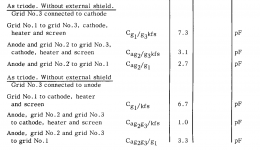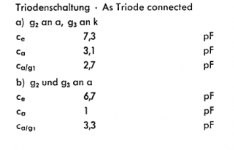I have the Telefunken data sheet for the D3A.
It does define the input capacitance for triode-connection.
However, being the data sheet is largely written in German, and I can only read English, I am having difficulty in obtaining the following information from the data sheet for the D3A:
Cathode to Grid Capacitance, Triode-Connection
Grid to Plate/Anode Capacitance, Triode-Connection
I need this information so I can calculate the Miller capacitance for a triode-connected D3A.
Can anyone help?
Thanks in advance!
It does define the input capacitance for triode-connection.
However, being the data sheet is largely written in German, and I can only read English, I am having difficulty in obtaining the following information from the data sheet for the D3A:
Cathode to Grid Capacitance, Triode-Connection
Grid to Plate/Anode Capacitance, Triode-Connection
I need this information so I can calculate the Miller capacitance for a triode-connected D3A.
Can anyone help?
Thanks in advance!
2.7pF G1 to anode. in triode connection with G3 tied to kathode.
3.3pF for G1 to anode with G3 tied to the anode.
Cg1/Cathode in pentode seems to be 6.8pF +-0.7pF so that ought to give you a ballpark. The data sheet uses a syntax that i am unfamiliar with.
3.3pF for G1 to anode with G3 tied to the anode.
Cg1/Cathode in pentode seems to be 6.8pF +-0.7pF so that ought to give you a ballpark. The data sheet uses a syntax that i am unfamiliar with.
v4lve lover, thanks very much! This was very helpful.
I can now calculate the Miller Effect capacitance with no issues.
All the Best,
Bruce
I can now calculate the Miller Effect capacitance with no issues.
All the Best,
Bruce
where is the problem ?
both Telefunken and Philips datasheet are in english
both list capacitances in triode connection ...
https://frank.pocnet.net/sheets/009/d/D3a.pdf
https://frank.pocnet.net/sheets/128/d/D3a.pdf
both Telefunken and Philips datasheet are in english
both list capacitances in triode connection ...
https://frank.pocnet.net/sheets/009/d/D3a.pdf
https://frank.pocnet.net/sheets/128/d/D3a.pdf
Attachments
What's the mu of a D3a in triode? It's high isn't it, like 70?
If the anode+g2 to g1 capacitance = 2.7pF, and you add 0.7pF to that to account for strays, you get 3.4pF. With the mu of 70, the input capacitance will be something like 250pF, which is even higher than that of a 12AX7.
If the anode+g2 to g1 capacitance = 2.7pF, and you add 0.7pF to that to account for strays, you get 3.4pF. With the mu of 70, the input capacitance will be something like 250pF, which is even higher than that of a 12AX7.
Rongon, the u of the triode-connected D3A is 77.
To calculate the Miller capacitance, you use the term u+1, so the value is 78 for the calculation.
To calculate the Miller capacitance, you use the term u+1, so the value is 78 for the calculation.
Exactly. By using mu you get the theoretical value of Miller capacitance, but in actual circuits the plate load and possible un-bypassed cathode resistor lower the gain and also Miller capacitance.
Which all means the input C of a D3a in triode is probably >250pF (if used as a mu-follower with a DN2540 plate load, for instance). That's high.
If using it as a driver for a 300B (for example), and with a volume control before its grid, you'd need to make sure that volume control doesn't interact with the input C to create too much of a HF rolloff.
E.g., If using a 100k pot for the volume control, its max output resistance will be 1/4 that, or 25k ohms.
F3 = 1/2piRC
If
C = 250pF (0.0000000025 F)
R = 25,000 ohms
F3 = 25,465 Hz !!!!
Ouch.
If you reduce the gain (and therefore the Miller C) by using a resistor for the plate load and leaving the Rk unbypassed, you've raised the rp of your D3a-triode and reduced its gain, making it a less effective driver of your 300B. Perhaps it's still good enough, though.
Another solution could be to use a 10k volume control, which would have a max Rout of only 2.5k ohms, which would yield an F3 of 254,648 Hz. You'd just have to make sure your sources can drive a 10k ohm load. Easy to do unless you use only vacuum tube-based sources and you have a religious aversion to cathode followers.
If using it as a driver for a 300B (for example), and with a volume control before its grid, you'd need to make sure that volume control doesn't interact with the input C to create too much of a HF rolloff.
E.g., If using a 100k pot for the volume control, its max output resistance will be 1/4 that, or 25k ohms.
F3 = 1/2piRC
If
C = 250pF (0.0000000025 F)
R = 25,000 ohms
F3 = 25,465 Hz !!!!
Ouch.
If you reduce the gain (and therefore the Miller C) by using a resistor for the plate load and leaving the Rk unbypassed, you've raised the rp of your D3a-triode and reduced its gain, making it a less effective driver of your 300B. Perhaps it's still good enough, though.
Another solution could be to use a 10k volume control, which would have a max Rout of only 2.5k ohms, which would yield an F3 of 254,648 Hz. You'd just have to make sure your sources can drive a 10k ohm load. Easy to do unless you use only vacuum tube-based sources and you have a religious aversion to cathode followers.
Last edited:
- Home
- Amplifiers
- Tubes / Valves
- Input Capacitance of a Triode-Connected D3A

